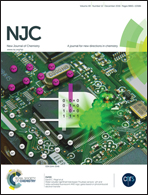Copper(ii) coordination properties of the Aβ(1–16)2 peptidomimetic: experimental evidence of intermolecular macrochelate complex species in the Aβ dimer†‡
Abstract
Alzheimer's disease (AD) is a neurodegenerative disorder characterized by the deposition of extracellular aggregates of amyloid-β peptides (Aβ). Different metal ions accumulate within amyloid deposits, which suggests an involvement of metal ions in AD pathogenesis. Cu(II)-induced Aβ neurotoxicity might result from changes in the coordination of the metal ion during Aβ oligomerization or from different peptide/metal ratios. Little is known on the Cu(II) complex with low-molecular-weight Aβ species. Here, we report our results on the Cu(II) coordination modes with a synthetic Aβ(1–16) dimer where the C-terminal 16Lys residue, of each peptide chain, is linked to a N,N-bis[(3-amino)propyl]glycine bearing a PEG moiety at the C-terminus. The formation of macrochelate complex species with the involvement of imidazole nitrogen donor atoms of His13 and His14, during copper(II) binding at physiological pH and low metal to peptide ratios, is observed.



 Please wait while we load your content...
Please wait while we load your content...